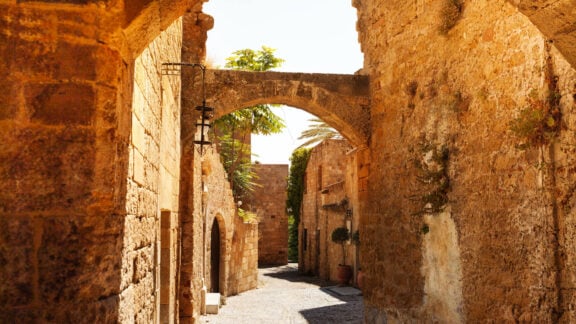It’s hard to write about Greek food and not discover all sorts of mythological and historical antidotes attached to the recipes or to why things were cooked in certain ways.
One of the most interesting stories is how we came to cook in vine leaves. According to Greek mythology dolmades where served with ambrosia and nectar on Mount Olympus.
It seems most likely that surrounding food in a vine leaf had more to do with practical matters than myth and the god’s self indulgence. When Alexander the Great besieged Thebes and strangled the supplies, the people of Thebes cut whatever little meat they had and wrapped it in vine leaves.
I have given the history of the dolma in a previous article along with the recipe.
I now want to concentrate on other foods that the vine leaf plays a serious role in.
As with the dolma, vine leaves were originally used for practical reasons. In the past, food was cooked outside on open fires.
There is nothing original about the BBQ or the souvla, it has been around for thousands of years. The Greeks built their houses in a square with a central courtyard where the cooking was done, as there was no kitchen, like we know it today.
Vine leaves, along with other leaves, were used to hold food together on the grill on top of the charcoal, but the vine leaf came out on top as it also added flavour to the food.
Try cooking a fish on a BBQ, it falls apart, wrap it in a vine leaf and see what happens, it stays in one piece and with lemon, pepper, salt and a little oregano it’s a recipe to make you lick your fingers. I presume, like any good Greek, you will have picked the head with your fingers and sucked the eyes out. This is a habit I have and makes my non-Greek friends shudder.
Given that the grape can do so much, it’s easy to forget its partner in crime on a tree – the leaf – an ingredient that can take a humble dish to a whole new level.
You can use either fresh leaves or preserved vine leaves found in a jar or tin that are readily available in Mediterranean delicatessens. This is handy for people who don’t have easy access to fresh vine leaves and also for recipes that require vine leaves when they are out of season. The brined alternative are generally used for wrapping dolmathes.
When using brined vine leaves, always be sure to wash them thoroughly prior to cooking to reduce the amount of salt on the leaves. Store the brined leaves in a cool, dry place and use within two days of opening. Brined vine leaves give a new dimension to cooking on the BBQ as it adds a layer of saltiness to the smokiness of the way the protein is cooked.
Using fresh vine leaves is a whole other ball game, but one that allows you to create a world of flavours depending on spices and ingredients used. Always use medium to large vine leaves that are light green in colour to take on the flavours.
Try and select leaves that haven’t browned and that are still in tact. Thoroughly clean the vine leaves and dry them in the same way you would any other green vegetable before cooking with it, and then remove the hard stem. The stem in the middle of the leaf can stay in tact as it softens while cooking. You only need to dip the vine leaf in boiling water for a few seconds and take it straight out as any longer will overcook them.
If you are using them to wrap food you will find they are too overcooked and will fall apart. You are looking at only wilting the leaf and not cooking it. When cooking with fresh leaves, only dip two to three leaves at a time to monitor the wilting process and not overcrowd the saucepan you are using.
Just a quick not to my readers, if you have any queries or would like me to reprint a recipe from a while back let me know. I will make an effort to meet your needs. I also would like to thank all those people who write to me with my personal queries and thank you all for clearing up the meaning of “koukoule”. I am also keen to share recipes with my readers, so if you would like to, or would even like me to publish a Hellenic inspired dish from my own personal collection, I would happily oblige. Send an email to dora@neoskosmos.com.au and just tell me whatever your foodie heart desires.








